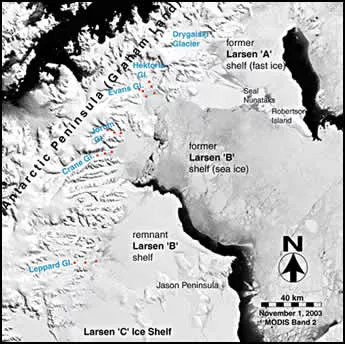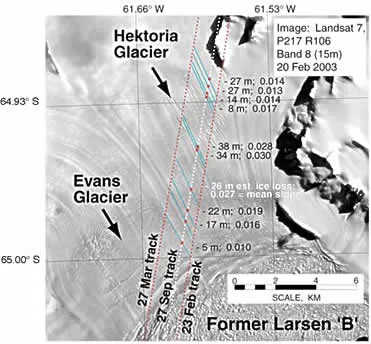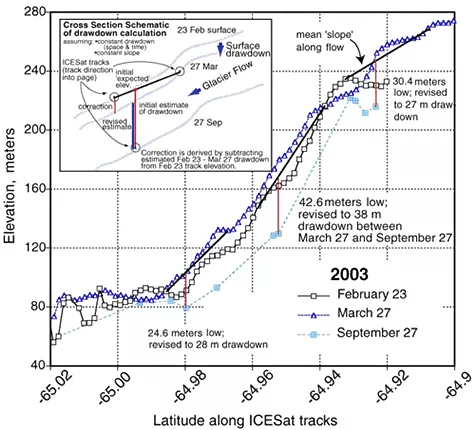Scientists at NSIDC have found that glaciers around the area of the Larsen B Ice Shelf accelerated immediately after it collapsed early in 2002, and are still speeding up.
The findings, presented at the AGU Fall 2003 Meeting in San Francisco, support earlier hypotheses that the ice shelf acted as a barrier, slowing the glaciers as they pushed up against the ice shelf, and that removing the barrier would cause the glaciers to speed up. This finding is significant, because it provides a smaller scale preview of what could occur if larger ice shelves –such as the Ross Ice Shelf– were to collapse.
The results refine earlier hints that removal of the Larsen A shelf and climate warming may be speeding up glaciers to the north (e.g., Drygalski Glacier). The earlier work was published by H. Rott of University of Innsbruck and P. Skvarka of Instituto Antarctica Argentina. Data for the Larsen B refine the timing of speed-up, and quantify the lowering of the ice shelf. The rapid speed-up at the glacier fronts begins within months of shelf removal, and progresses upstream.
Satellite images spanning the period before, during and after the break-up of the Larsen B Ice Shelf in March 2002 show this acceleration in several glaciers feeding into the now-disintegrated area of the shelf. According to velocity data from Landsat images from January of 2000 through February of 2003, Crane Glacier and the Hektoria-Green-Evans glacier system have all sped up. The speeds on the Crane Glacier increased from 1.7 meters/day to 3.1 meters/day in April through December of 2002, and then to 4.1 meters/day between December 2002 and February of 2003. This represents nearly a 250% increase in speed.
The results imply that ice shelf removal has a significant, rapid effect on feeder glacier flow, that the removal of the ice shelf directly affects glacier force balance, and, most importantly, that climate-related shelf removal for other large shelves fed by major ice streams are likely to result in a rapid speed-up of those glaciers and a change in the mass balance of the adjacent ice sheet, with a consequent impact on global sea level.
For more information, or to speak to a research scientist about this story, please contact NSIDC User Services at nsidc@nsidc.org or 303.492.1497.


